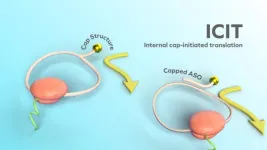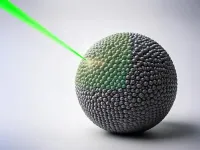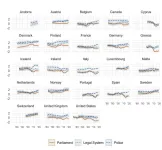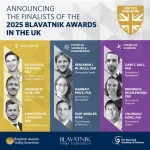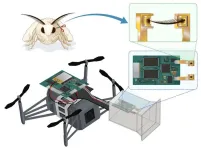(Press-News.org) Procedure is simple and could be adopted by most U.S. hospitals
Roughly 2 million people in the U.S. live with limb loss; number is expected to rise
Senior author, a retired U.S. Army colonel, traveled to Ukraine to set up the study
CHICAGO --- A reliable method to treat post-amputation pain remains elusive, but a new Northwestern Medicine study conducted in collaboration with Ukrainian physicians suggests that hydrodissection — a simple procedure that injects fluid around nerves — may reduce residual limb pain and opioid dependence.
The study is the first to evaluate hydrodissection for post-amputation pain, a condition affecting millions worldwide that is notoriously difficult to treat.
It will be published on Wednesday (Feb. 19) in Regional Anesthesia & Pain Medicine.
“Adding hydrodissection to opioid treatment for post-amputation pain not only appears to improve pain outcomes, but also shows mental-health benefits,” said senior study author Dr. Steven P. Cohen, a professor of anesthesiology and the vice chair of research and pain medicine at Northwestern University Feinberg School of Medicine.
For young veterans, finding safer alternatives to opioids is especially crucial, said Cohen, a retired U.S. Army colonel who traveled to Ukraine to help set up the study. Many face a high risk of opioid dependence due to severe psychological trauma.
How the study was conducted
Scientists followed 74 Ukrainian soldiers and civilians who had undergone traumatic limb amputations due to war injuries. Thirty-eight patients received hydrodissection alongside opioid therapy within six months of amputation, while 36 received opioids alone.
The study showed that hydrodissection combined with opioids provided better pain relief and reduced opioid use. On a 0–10 pain scale, the hydrodissection group reported an average pain reduction of 4 points, compared to 3 points for those on opioids alone — a significant difference considered clinically meaningful in most studies.
Additionally, nearly two-thirds of patients in the hydrodissection group reduced their opioid use, while only about one-third of the opioid-only group did. Patients receiving hydrodissection also reported lower anxiety levels. However, its effects on phantom limb pain and chronic pain were more limited.
Findings are ‘highly relevant to Americans’
Post-amputation pain is a major challenge for both veterans and civilians worldwide, often preventing amputees from using prosthetics and reducing their quality of life.
An estimated 100,000 Ukrainians have suffered war-related amputations since Russia’s full-scale invasion of Ukraine. In the U.S., more than 2 million people live with limb loss, a number that is expected to rise sharply due to aging populations and increasing rates of diabetes and vascular disease.
“This research is highly relevant to Americans,” Cohen said. “Trauma is the leading cause of upper-extremity amputations worldwide, and post-amputation pain affects most amputees, limiting their reintegration into society.”
Hydrodissection is remarkably simple
Hydrodissection is an ultrasound-guided procedure where fluid is injected into scar tissues around nerves to relieve pressure, reduce inflammation and promote healing. While the technique has shown promise for acute and neuropathic pain, its effectiveness for post-amputation pain, specifically, had not been previously studied.
“It’s remarkable how simple and accessible this technique is — requiring just an ultrasound and a needle. It can be easily adopted by most community hospitals in the U.S.,” said Cohen.
Returning to Ukraine
Given the challenges of conducting research during wartime, the study was exploratory, not controlled. Still, Cohen intends to return to Ukraine this spring to launch new randomized trials focused on novel treatments for post-amputation pain, traumatic brain injury, and PTSD — undeterred by the dangers of working in a conflict zone.
A veteran of four overseas tours in support of military operations and a father to a son currently serving in the infantry, Cohen is also analyzing data on botulinum toxin injections for amputees and examining how mental health factors, such as depression and anxiety, impact phantom limb pain and recovery outcomes.
The other study authors are Dr. Dmytro Dmytriiev who is a pioneer on the use of hydrodissection for postamputation pain, Winnie L. Liu, Dr. Maksym Barsa, Dr. Andreii Khomenko, Dr. Andreii Strokan and Dr. Paul F. Pasquina.
This research was partly supported by the U.S. Dept. of Defense and Uniformed Services University, Department of Physical Medicine & Rehabilitation.
END
A new treatment for post-amputation pain?
War study in Ukraine suggests hydrodissection may reduce pain, opioid use in amputees
2025-02-19
ELSE PRESS RELEASES FROM THIS DATE:
Groundbreaking study reveals how topology drives complexity in brain, climate, and AI
2025-02-19
(Embargo: 19 Feb, 10am GMT) A groundbreaking study led by Professor Ginestra Bianconi from Queen Mary University of London, in collaboration with international researchers, has unveiled a transformative framework for understanding complex systems. Published in Nature Physics, this pioneering study establishes the new field of higher-order topological dynamics, revealing how the hidden geometry of networks shapes everything from brain activity to artificial intelligence.
“Complex systems like the brain, climate, and next-generation artificial intelligence rely on interactions that extend beyond simple pairwise relationships. Our study reveals ...
Lifestyle and environmental factors affect health and ageing more than our genes
2025-02-19
A new study led by researchers from Oxford Population Health has shown that a range of environmental factors, including lifestyle (smoking and physical activity), and living conditions, have a greater impact on health and premature death than our genes.
The researchers used data from nearly half a million UK Biobank participants to assess the influence of 164 environmental factors and genetic risk scores for 22 major diseases on ageing, age-related diseases, and premature death. The study is published today in Nature Medicine.
Key findings
Environmental factors explained 17% of the variation in risk of death, compared to less than 2% explained by genetic predisposition (as ...
New mRNA produces 200 times more protein: Hope for treatment of cancer and protein disorders
2025-02-19
Imagine a breakthrough in cancer treatment where only malignant cells are targeted, sparing healthy host cells; or patients with abnormal protein synthesis are treated to produce a healthy protein. Hiroshi Abe and his colleagues at Nagoya University have identified two applications, among others, in a new study. Their innovative approach, reported in Nature Biotechnology, called the Internal Cap-Initiated Translation (ICIT) mechanism, introduces a novel way to 'switch on' protein synthesis ...
Magnetic semiconductor preserves 2D quantum properties in 3D material
2025-02-19
UNIVERSITY PARK, Pa. — There is a big problem with quantum technology — it’s tiny. The distinctive properties that exist at the subatomic scale usually disappear at macroscopic scales, making it difficult to harness their superior sensing and communication capabilities for real-world applications, like optical systems and advanced computing. Now, however, an international team led by physicists at Penn State and Columbia University has developed a novel approach to maintain special quantum characteristics, even in three-dimensional (3D) materials.
The researchers published ...
Magnetic switch traps quantum information carriers in one dimension
2025-02-19
Illustration
A quantum "miracle material" could support magnetic switching, a team of researchers at the University of Regensburg and University of Michigan has shown.
This recently discovered capability could help enable applications in quantum computing, sensing and more. While earlier studies identified that quantum entities called excitons are sometimes effectively confined to a single line within the material chromium sulfide bromide, the new research provides a ...
Using light to activate treatments in the right place
2025-02-19
Acting in the right place at the right time is the key to effective medical treatment with minimal side effects. However, this feat remains difficult to achieve. Biologists and chemists at the University of Geneva (UNIGE) have succeeded in developing a tool that controls the location at which a molecule is activated by a simple pulse of light lasting only a few seconds. Tested on a protein essential for cell division, this system could be applied to other molecules. The potential applications are vast, both in basic research and in improving ...
Democracy in crisis: Trust in democratic institutions declining around the world
2025-02-19
New research from the University of Southampton has found that trust in representative institutions, such as parliaments, governments and political parties, has been declining in democratic countries around the world.
The study, published in The British Journal of Political Science, presents the largest and most comprehensive analysis of trends in political trust worldwide to date. It brings together results from 3,377 surveys covering 143 countries between 1958 and 2019, representing over five million survey respondents.
Whereas trust in representative institutions is generally in decline, trust in non-representative institutions ...
Finalists announced for the 2025 UK Blavatnik Awards for Young Scientists
2025-02-19
19 February 2025 – London – The Blavatnik Family Foundation and The New York Academy of Sciences today announced the Finalists for the eighth Blavatnik Awards for Young Scientists in the United Kingdom. The Awards recognise scientific advances by UK researchers across Life Sciences, Chemical Sciences, and Physical Sciences & Engineering.
On Wednesday, 4 March, Professor Shitij Kapur, FMedSci, Vice-Chancellor & President, King’s College London, will announce the three 2025 Laureates at a gala dinner and awards ceremony. The three Laureates will each receive an unrestricted award of £100,000 (US$126,000). ...
Bio-hybrid drone uses silkworm moth antennae to navigate using smell
2025-02-19
Conventional drones use visual sensors for navigation. However, environmental conditions like dampness, low light, and dust can hinder their effectiveness, limiting their use in disaster-stricken areas. Researchers from Japan have developed a novel bio-hybrid drone by combining robotic elements with odor-sensing antennae from silkworm moths. Their innovation, which integrates the agility and precision of robots with biological sensory mechanisms, can enhance the applicability of drones in navigation, gas sensing, and disaster response.
Technological advances have led to the development of drones with diverse applications, ...
Do seizures in newborns increase children’s risk of developing epilepsy?
2025-02-19
Seizures in newborns are one of the most frequent acute neurological conditions among infants admitted to neonatal care units. A study published in Developmental Medicine & Child Neurology indicates that newborns experiencing such neonatal seizures face an elevated risk of developing epilepsy.
For the study, investigators analyzed data on all children born in Denmark between 1997 and 2018, with the goal of comparing the risk of epilepsy in children with and without neonatal seizures.
Among 1,294,377 children, the researchers identified 1,998 who experienced neonatal seizures. The cumulative risk of epilepsy was 20.4% among children with neonatal seizures compared with 1.15% among children ...
LAST 30 PRESS RELEASES:
Post-stroke injection protects the brain in preclinical study
Cardiovascular risk score predicts multiple eye diseases
Health: estimated one in ten British adults used or interested in GLP-1 medications for weight loss
Exercise to treat depression yields similar results to therapy
Whooping cough vaccination for pregnant women strengthens babies’ immune system
Dramatic decline in new cases of orphanhood in Uganda driven by HIV treatment and prevention programs
Stopping weight loss drugs linked to weight regain and reversal of heart health markers
Higher intake of food preservatives linked to increased cancer risk
Mass General Brigham–developed cholera vaccine completes phase 1 trial
First experimental validation of a “150-year-old chemical common sense” direct visualization of the molecular structural changes in the ultrafast anthracene [4+4] photocycloaddition reaction
Lack of support for people on weight loss drugs leaves them vulnerable to nutritional deficiencies, say experts
Dogs’ dinners can have greater climate impact than owners’
Are you ready to swap salmon for sprats and sardines?
1.6 million UK adults used weight loss drugs in past year
American College of Cardiology comments on new dietary guidelines for Americans
American Society of Gene & Cell Therapy and Orphan Therapeutics Accelerator partner to advance and commercialize promising rare disease treatments
One in 14 patients having day case surgery have new or worse chronic pain 3 months after their operation
New study highlights link between eviction rates and gun violence
Heatwaves heat up soil but not toxin levels in rice, study finds
Digital modeling reveals where construction carbon emissions really come from
Turning farm waste into water filters
New study shows how the spleen helps the immune system accept a transplant
New Mayo Clinic study advances personalized prostate cancer education with an EHR-integrated AI agent
Researchers identify novel therapeutic target to improve recovery after nerve injury
Microbes in breast milk help populate infant gut microbiomes
Reprogramming immunity to rewrite the story of Type 1 diabetes
New tool narrows the search for ideal material structures
Artificial saliva containing sugarcane protein helps protect the teeth of patients with head and neck cancer
Understanding the role of linear ubiquitination in T-tubule biogenesis
Researchers identify urban atmosphere as primary reservoir of microplastics
[Press-News.org] A new treatment for post-amputation pain?War study in Ukraine suggests hydrodissection may reduce pain, opioid use in amputees

